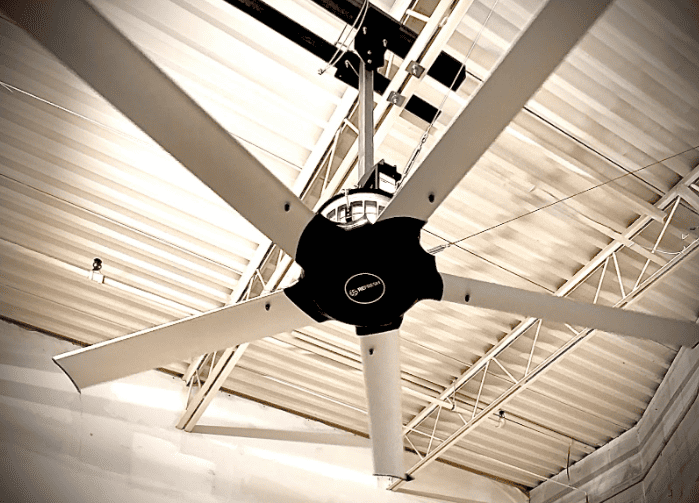
The landscape of industrial and commercial spaces is constantly evolving, driven by ongoing technological advancements on a global scale. The progress in High Volume, Low Speed (HVLS) fan technology serves as a prime example of this trend.
HVLS fans excel in efficiently circulating significant volumes of air at lower speeds, finding broad applications in expansive environments like warehouses and manufacturing facilities across the globe. In a world increasingly dedicated to enhancing energy efficiency and effectively managing diverse climates, the coming years and the innovations they bring to HVLS fan technology will be of utmost importance.
The Present State of HVLS Fan Technology
Before delving into the future, let’s briefly assess the current state of HVLS fan technology. With diameters spanning up to 24 feet, HVLS fans are designed to gently and effectively move large masses of air. The unique design and engineering of HVLS fans create a mild breeze that covers extensive areas, making them particularly suitable for spaces with high ceilings and open layouts.
The advantages of HVLS fans have gained worldwide recognition. They contribute to temperature regulation by reducing temperature stratification and ensuring efficient mixing of warm air near the ceiling and cooler air near the floor. This makes them indispensable tools for heating and cooling, thus enhancing working conditions and potentially conserving energy.
The Future of HVLS Fan Technology: Innovations in Installation
As technology advances, there is a simultaneous potential for groundbreaking developments in the design and installation of HVLS fans. Here are a few exciting possibilities that could greatly benefit the industry:
- Integration of Smart Fans
Imagine a future where HVLS fans seamlessly integrate with building management systems worldwide. This integration would enable automated control based on real-time occupancy data, temperature variations, and humidity levels. Smart fans could communicate with other building systems to optimize airflow patterns and adjust fan speeds for optimal comfort and energy efficiency. Such a level of automation has the potential to revolutionize the application and maintenance of HVLS fans on a global scale.
- Enhanced Blade Designs
Advancements in blade design could enhance the efficiency of HVLS fans. Engineers are exploring aerodynamic shapes and innovative materials that amplify the fan’s capacity to move air while concurrently demanding less energy. Reduced energy consumption would not only result in cost savings but would also align seamlessly with sustainability objectives.
- Adaptive Airflow Patterns
Future iterations of HVLS fans could adapt their airflow patterns based on the layout and usage of the space. By intelligently directing airflow to where it’s most needed, these fans could offer even more precise control over temperature and air quality. This adaptability would make them exceptionally versatile across various industrial and commercial contexts.
- Noise Mitigation
Noise levels can sometimes be a concern in spaces with multiple HVLS fans. Future innovations might concentrate on minimizing fan noise without compromising on performance. The quieter operation would significantly contribute to a more conducive and productive environment for workers.
- Elevated Aesthetics
While HVLS fans are primarily functional, their size can dominate the visual landscape. Future designs could prioritize aesthetics by offering a wider array of customizable options, including colours and materials. This could facilitate the seamless integration of HVLS fans into the overall design scheme of a space.
HVLS Fan Technology on a Global Scale
Given the planet’s diverse climatic conditions and expansive industrial footprint, HVLS fan technology holds immense potential on a global scale. In regions with extreme temperatures, HVLS fans could play a crucial role in mitigating cold air accumulation at ground level. This could promote a more uniform heat distribution, ultimately reducing the strain on heating systems and lowering operational costs for businesses.
Conversely, during warmer months, HVLS fans could aid in maintaining comfortable indoor temperatures by encouraging air circulation and preventing hot air buildup near the ceiling. This cooling effect is particularly valuable in spaces without air conditioning, offering a cost-effective solution for managing extreme temperatures.
Furthermore, the global emphasis on sustainability and energy efficiency aligns perfectly with the core advantages of HVLS fans. The potential for energy savings, especially in large industrial and commercial settings, positions HVLS fan technology as a crucial component of worldwide efforts to reduce carbon emissions.
Conclusion
In conclusion, the future holds remarkable promise as we gaze toward the horizon of HVLS fan technology. The evolution of these fans, from their current state to the innovative possibilities on the horizon, underscores the ongoing commitment to enhanced efficiency, sustainability, and comfort in our industrial and commercial spaces.
At Refresh Fans, we are excited to be at the forefront of this transformative evolution. Engineered to provide seamless functionality without any performance compromises, Refresh Fans empower businesses to achieve energy savings and cost reductions while making a positive environmental impact. As the landscape of HVLS fan technology continues to evolve, we at Refresh Fans are prepared to shape the future, one revolution at a time. Join us in embracing the winds of change and experience the unparalleled comfort and efficiency that Refresh Fans brings to the world of HVLS technology.